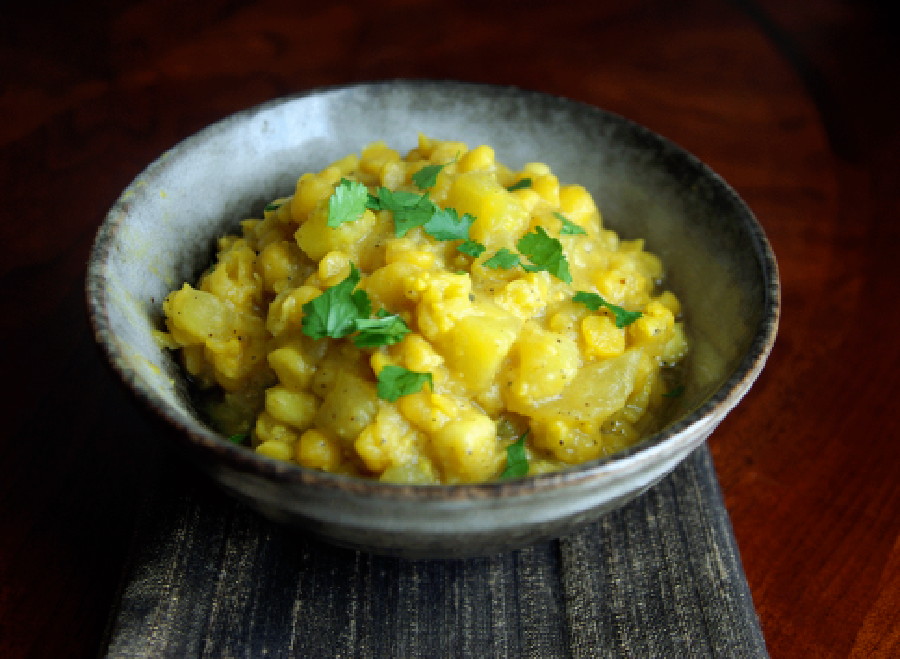A version of this post first appeared on Beth Fortune’s Open Salon blog.
“So, now that you, you know, got cancer, do you think you’ll switch to a macrobiotic diet?” a friend asked me. Shit, I thought. It’s not bad enough to have cancer? Now I have to eat umeboshi paste?
I get why people follow a macrobiotic diets, raw food diets, blood type diets, any diet after a cancer diagnosis. We want to minimize risk, take control. Some of us feel better when we have a lot of rules to follow. I think most of them probably work, as most of them emphasize real food and minimize known carcinogens, like charred meat and alcohol. But I can’t do diets. Food is one of the greatest pleasures in my life, and I can’t bring myself to cut out entire categories of it. Cut down, yes. Cut out, no.
I prefer an additive rather than subtractive approach. I like to focus on foods that fight cancer, like berries, the cabbage family, mushrooms and flax seeds. So when I heard about new research about an old Ayurvedic wonder spice, I tried to make it work. I am a fan of David Servan-Schreiber, of his book “Anticancer, A New Way of Life” and of his blog, in which he updates readers with current research. Recently, an e-mail landed in my in box, informing me that turmeric, the spice that makes curry powder yellow, has some lab-proven anti-cancer properties, especially when combined with black pepper. Servan-Schreiber recommends consuming a “soupspoon” of the stuff a day. Perfect, I thought. I like curry. I’m a trained professional. I can make this work.
Turmeric is a rhizome, like ginger, that is most often dried and ground to a powder. It has been used in Ayurvedic medicine for thousands of years, and is thought to have powerful antiseptic and anti-inflammatory properties, among many others. Recently, Madhuri Kakarala published the results of her most recent study that show that curcumin, the active compound in turmeric, in combination with piperine, found in black pepper, are capable of eliminating breast cancer stem cells without harming the surrounding healthy cells. Like most foods that prevent cancer from growing, there is little downside to consuming the combination, at least health-wise.
The thing about turmeric is that it’s used in cooking primarily for color, not flavor. Alone, it tastes mostly bitter, slightly acrid. Almost, well, medicinal. Most recipes use it as one of many spices, rarely more than a half teaspoon at a time. Still, I thought, I can do this. I planned to make a batch of yellow split peas, warm and filling, redolent of Indian spices.
I added a tablespoon of turmeric to that first batch, along with more reasonable amounts of coriander, cumin and mustard seeds. Even my husband, with a palate dulled by years of allergies, noticed the flavor was off. We ate it anyway, but it did not make us feel healthy, or happy.
This weekend, craving warm flavor and comfort as we waited out a tsunami warning, I tried it again. This time, I took it easy with the turmeric. I finished the soup with a little butter to smooth out the flavor. We ate it, and we felt good about it, and I decided that a soupspoon of turmeric a day is probably best consumed in supplement form. Life’s too short to eat stuff you don’t like.
Yellow Split Peas with Cauliflower and Yam
Ingredients:
1 tablespoon olive oil
2 cups chopped onions
1 teaspoon black peppercorns
1 teaspoon coriander seeds
¾ teaspoon cumin seeds
½ teaspoon mustard seeds
1 teapoon ground turmeric
2 carrots, peeled and chopped (about 1 cup)
1 jalapeño pepper, seeded and chopped (about 1 tablespoon)
2 tablespoons peeled and minced fresh ginger
1 small yam, peeled and cubed (about 2 cups)
2 cups small cauliflower florets, about half a head
2 cups yellow split peas, sorted and rinsed
salt, to taste
2 tablespoons butter
- Heat olive oil in a large, heavy pot (a Dutch oven is ideal). Cook onions slowly over low, even heat until browned and tender, about 20 minutes.
- While onions are cooking, prepare the spice mixture. Heat a small skillet. Toast whole spices in pan, starting with the biggest seeds, the peppercorns and the coriander. Spices are toasted when they are aromatic; cumin and mustard seeds will begin to pop. Grind in spice grinder or mortar and pestle. Add turmeric. Set aside. (Note: You can use pre-ground spices for this mixture, but toasting whole spices lends depth to the dish.)
- Add carrots, cauliflower and yam to the onions. Stir and cook, about 5 minutes. Add ginger and jalapeño, cook a few minutes more. Add reserved spice mixture, stir, cook for another 2 minutes. Add 4 cups water, then split peas, stir. Bring to a simmer, reduce heat, and cook, uncovered, about an hour. Stir occasionally and add more water if needed.
- When split peas are cooked, add salt and butter. Taste, and adjust seasonings as desired. Serve with a dollop of plain yogurt and fresh cilantro, if desired.

